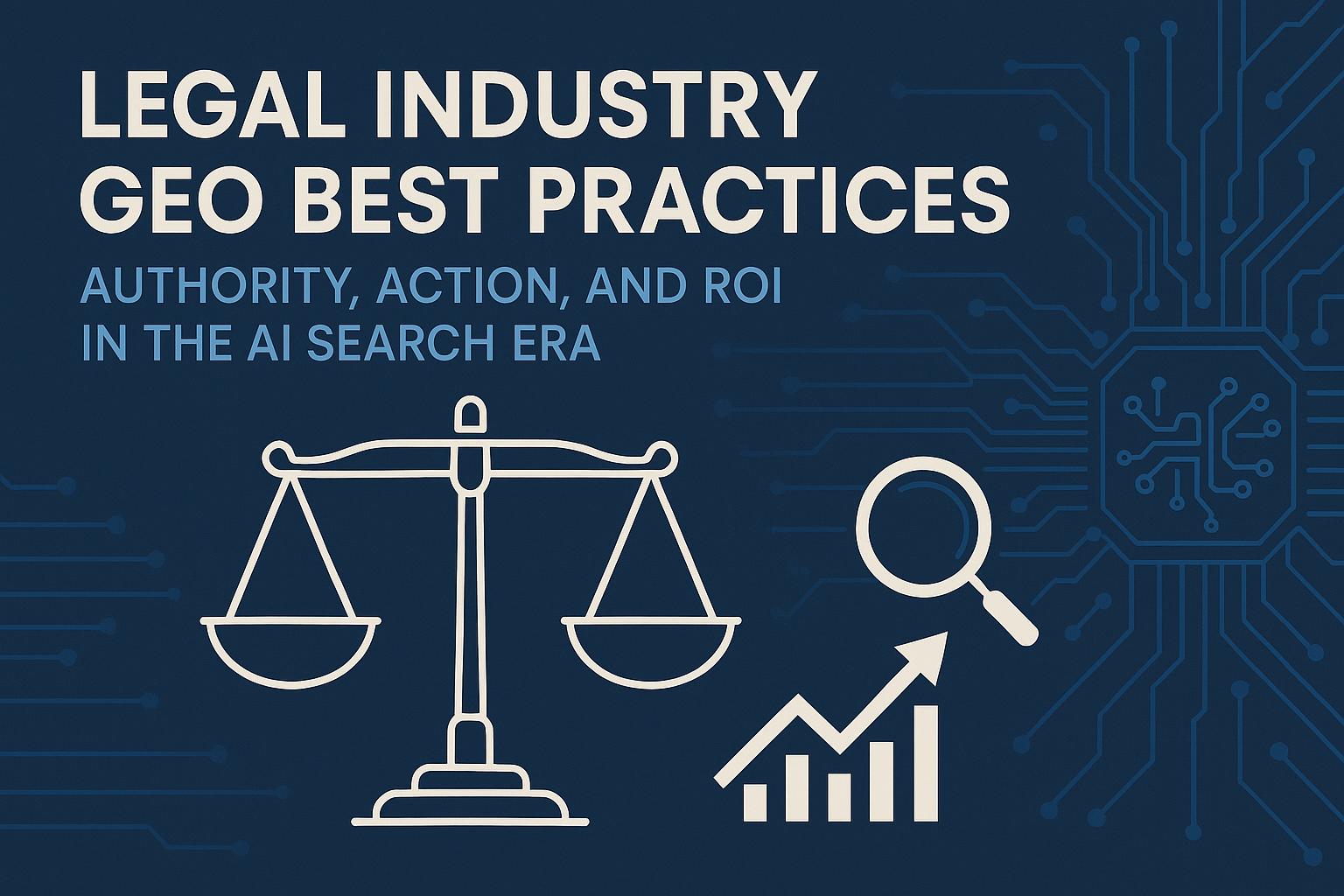Legal Industry GEO Best Practices: Authoritative Guide to AI Search, Content, and ROI (2025)
Discover the latest legal industry GEO (Generative Engine Optimization) best practices for 2025. Learn actionable AI search strategies, workflow, top tools, and proven ROI to boost law firm visibility and leads.

Introduction: Why GEO Now Matters for Law Firms
Legal searches are rapidly shifting: AI-driven tools like ChatGPT, Google AI Overviews, and Gemini now answer core legal queries directly, often before prospects even see a law firm’s website. According to Gartner’s 2024 forecast, traditional search traffic is predicted to decline by 25% by 2026, while over 70% of users trust results generated by AI platforms. Legal marketers, SEO managers, and digital directors are now challenged to make their firm the go-to source these AIs quote and recommend.
Generative Engine Optimization (GEO) is not a trend—it’s the critical layer for law firms wanting to secure visibility, credibility, and leads in this new paradigm. This guide condenses the latest, evidence-based best practices, proven workflows, and the tools advanced legal marketers rely on to win the legal AI search game.
The Ultimate Legal GEO Best Practices Checklist
Audit Your AI Search Presence and Market Position
Craft Structured, AI-Optimized Legal Content Addressing Real User Questions
Implement Schema Markup and Entity-Rich Data Signals
Fix Technical Barriers to AI Accessibility
Pursue Strategic External Citations and Authority Mentions
Leverage Visuals and Multimedia for AI and User Engagement
Monitor, Measure, and Iterate GEO Performance with Modern Tools
1. Audit Your AI Search Presence and Market Position
What & Why: GEO begins with understanding where your law firm appears (or is absent) in leading AI answers. A systematic audit establishes a baseline for improvement, shows which queries trigger AI answers, and reveals who is being cited as the authority.
How:
Query AI engines (ChatGPT, Gemini, Google AI Overviews, Bing Copilot) with real-world legal questions in your practice areas.
Inventory: Which questions do you appear in? Who does the AI cite? Is your brand referenced, and if so, why?
Use GEO monitoring tools like AI Monitor, Semrush, and SERanking for multi-platform visibility tracking, brand mention analysis, and cross-platform comparison.
Assess your presence in top legal directories, industry listicles, and trusted external sites—AI engines favor entities featured by reputable third parties (First Page Sage, 2025).
Impact: Top-performing law firms have achieved up to 72% inclusion in AI Overviews and 28% direct citations (GrowLawFirm Case Data).
2. Craft Structured, AI-Optimized Legal Content Addressing Real User Questions
What & Why: AI platforms prioritize accurate, direct, and conversational answers to legal queries—often via FAQ content and scenario-based guides. The heart of GEO is content that solves real client problems, in the format and language that AI understands.
How:
Build a content matrix using Q&A style articles that mirror typical queries from your market (e.g., “How does personal injury compensation work in [city]?”).
Create pillar pages and practice-area-specific guides that group legal topics by entity, jurisdiction, and scenario.
Use conversational language and segment by real-life case questions, not just keywords.
Integrate authoritative legal facts, recent regulatory updates, references to statutes, and cite reputable sources with structured links.
Continuously update answers as laws or AI behaviors evolve.
Impact: Firms implementing this approach have reported up to 106% increase in conversion rate and 900%+ increase in qualified leads (Omar Ochoa Law Firm GEO Case).
3. Implement Schema Markup and Entity-Rich Data Signals
What & Why: Schema.org markup and structured data help AI engines “understand” your content’s context and credibility, drastically increasing the likelihood of being cited in an AI-generated answer.
How:
Apply structured data for FAQ, attorney profiles, practice areas, and review/rating sections (Google Structured Data Guidelines).
Identify and mark up key legal entities (jurisdictions, services, processes) with appropriate JSON-LD or microdata.
Use contextual tags linking to recognized legal concepts and authoritative resources.
Impact: Schema and entity-rich signals are directly linked to improved inclusion rates in AI Overview responses (ManhattanStrategies).
4. Fix Technical Barriers to AI Accessibility
What & Why: Even the best content fails if your site is not crawlable or compatible with GPTBot, PerplexityBot, and other AI engines. Technical hygiene is non-negotiable.
How:
Correct indexing issues, broken pages, and ensure your robots.txt does not block AI crawlers.
Optimize site speed, mobile usability, and HTTPS security.
Apply appropriate alt text and metadata for visuals and non-text assets.
Improve internal linking structure so pages reinforce each other’s authority and topical depth.
Impact: Removing technical roadblocks contributes to faster citation growth and improved trust from AI engines (GrowLawFirm Implementation Process).
5. Pursue Strategic External Citations and Authority Mentions
What & Why: AI platforms favor brands and entities that are frequently cited by third-party publications, legal directories, and trusted databases. Reputation and external “hype” are almost as critical as your own website content.
How:
Conduct outreach to reputable legal publishers, association websites, and respected review platforms for profiles and citations.
Seek inclusion in recognized lists (e.g., “Top Law Firms in [Area]” articles).
Gather and promote authentic positive reviews on Google, Yelp, and especially legal-specific platforms (First Page Sage, 2025).
Monitor your brand’s AI mentions and sentiment using tools like BrandRank.ai and AI Monitor.
Impact: Industry benchmarks show leading GEO-focused firms achieve 400% to 2,900%+ marketing ROI, with direct correlation to external citation volume and brand sentiment (GrowLawFirm Case Data).
6. Leverage Visuals and Multimedia for AI and User Engagement
What & Why: AI search systems increasingly favor answers enriched with visuals—charts, infographics, explainer videos, and branded imagery. Visuals reinforce legal expertise, boost recall, and elevate your inclusion odds.
How:
Embed infographics explaining legal processes, timelines, or case studies.
Create explainer videos for critical questions.
Apply schema, alt text, and structured metadata to all multimedia assets.
Optimize visual assets for both social sharing and AI readability.
Impact: Law firms employing multimedia in their GEO content report higher engagement rates and increased frequency of AI feature placements (HubSpot).
7. Monitor, Measure, and Iterate GEO Performance with Modern Tools
What & Why: Effective GEO is a continuous, data-driven process. Technical audits, sentiment analysis, and performance dashboards ensure you adapt to evolving AI algorithms and never lose your search advantage.
How:
Deploy at least one purpose-built GEO monitoring tool (AI Monitor, SERanking, Profound) for tracking citations, mentions, sentiment, and cross-platform visibility.
Set up Google Analytics, GSC, and AI referral tracking to monitor lead and conversion sources.
Analyze which Q&A, pages, and topics drive the most AI citations and leads.
Iterate: Regularly refresh top-performing content and retire or revamp underperformers.
A/B test content formats and prompt variants to discover what resonates best with AI engines and users.
Impact: Law firms using modern GEO performance frameworks consistently report ROI gains of 400–2,900%, and outperform non-GEO competitors in lead volume and engagement.
Success Case: GEO ROI in the Legal Sector
Omar Ochoa Law Firm
921% Marketing ROI, 900%+ Increase in Qualified Leads, 917% Organic Traffic Growth (Case Study).
How? Structured content overhaul, schema deployment, strategic authority citation campaigns, and persistent brand monitoring in AI and legal publisher ecosystems.
Texas Horizons Law Group
860% Lead Growth, 4,566% Organic Traffic Increase (Case Study) — achieved via full-scope GEO workflow implementation.
Benchmark: Top GEO law firms feature in 72% of AI Overviews and are cited as source in 28% of direct AI answers (GrowLawFirm, AI Monitor, 2025).
Legal GEO Tools You Should Know
AI Monitor: Real-time, cross-platform AI citation tracking, sentiment and brand monitoring.
SERanking: Google AI Overview and classic SEO/GEO performance analytics.
Profound: Advanced enterprise-grade legal sentiment and AI brand risk analysis.
BrandRank.ai: Trust and reputation scoring for legal brands in the AI search context.
Semrush: Traditional and AI-oriented content and website reporting.
Conclusion & Next Actions
AI-driven search has moved from the cutting edge to the mainstream. Law firms are winning new clients and driving extraordinary ROI—not because of old “SEO hacks,” but by embedding GEO throughout their content, technical infrastructure, reputation, and analytics workflows.
If you take away one lesson: Content that solves real legal problems—delivered in a format trusted by both users and AI—is the single most powerful driver of visibility and growth in the generative search era.
Next Steps:
Audit your law firm’s current AI presence.
Map out priority queries and eligible practice areas for targeted GEO content.
Implement the workflow checklist above—starting now.
Leverage industry-best tools for monitoring, sentiment, and performance analytics.
Stay agile: revisit your GEO practices quarterly to stay ahead of competing law firms and evolving AI algorithms.




